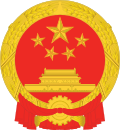| Mayor of the Guangzhou Municipal People's Government | |
|---|---|
| 广州市人民政府市长 | |
 | |
since October 9, 2023 | |
| Guangzhou Municipal People's Government | |
| Type | Head of government |
| Reports to | Guangzhou Municipal People's Congress and its Standing Committee |
| Appointer | Guangzhou Municipal People's Congress |
| Term length | Five years, renewable |
| Deputy | Deputy Mayors |
| Mayor of Guangzhou | |||||||
|---|---|---|---|---|---|---|---|
| Traditional Chinese | 廣州市市長 | ||||||
| Simplified Chinese | 广州市市长 | ||||||
| |||||||
The mayor of Guangzhou,officially the Mayor of the Guangzhou Municipal People's Government,is the head of the Guangzhou Municipal People's Government. The mayor generally serves as the deputy secretary of the Guangzhou Municipal Committee of the Chinese Communist Party,and is the second-highest ranking official in the city after the secretary of the CCP Guangzhou Committee.


